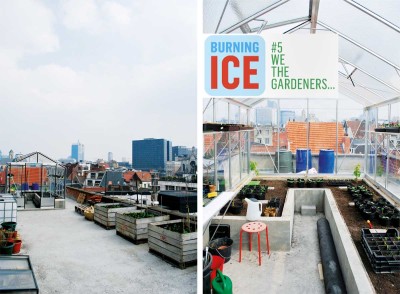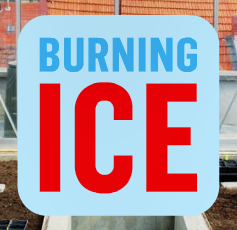Nature and culture; this has always been a tense relationship. Whereas culture was once meant to protect man from nature, we now have to protect nature from culture. In spite of all our ecological intentions, we even now consider that nature exists ‘for us’. Climate change, the world population explosion and diminishing stocks of many natural resources are putting increasing pressure on this anthropocentric attitude, but there is still no sign of any about-turn. Nature must in the first place be of economic use, and should furthermore provide us with a degree of aesthetic pleasure.
In the fifth Burning Ice, Kaaitheater is showing the work of artists inspired by the rising tension between nature and culture. As always, we also let scientists and theorists have their say.
https://www.kaaitheater.be/nl/agenda/burning-ice-5

UAF -urban artfarm and greenhouse on top of a parking lot in Brussels;
an ongoing project by Annemie Maes in search of sustainable cities of the future.
Carolyn Steel is an architect and writer. She has taught at the London School of Economics, London Metropolitan University and Cambridge University. Hungry City (2008) is an enthusiastic, visionary, unmissable book and international bestseller.
Carolyn Steel follows the trail of our food, from countryside to city, via markets and supermarkets, kitchens and dining rooms, waste disposal and back. She asks herself how we can use food more effectively to better understand our cities, to improve their design, and to make them into more pleasant places to live. She sketches a clear picture of how modern food production impacts our planet and our lives, offering insights into how things were allowed to get this far, and suggesting where we should go from here.
It’s the latest trend: producing food in the middle of the city. From allotments and urban bees to vertical farming and edible roofs, there’s no lack of initiatives. The reasons vary, but they are all pressing: the enhancement of social cohesion, reducing food miles, education on where food comes from, climate change and the preservation of greenery in cities. At a time when 50% of the world’s population lives in urban areas, we should not underestimate how much this ‘urban agriculture’ can contribute to making the city more livable and sustainable. The aim of Voorraad BRXL Réserve is to demonstrate that urban farming in Brussels is alive and has potential. This project brings together several existing initiatives that will be able to introduce their projects.
The artist Annemie Maes, the driving force behind OKNO, a centre for art and media technology, has installed ten beehives in two roof gardens in Brussels’ canal zone – there is now a beehive on the Kaaitheater roof as well. Bees provide us with important information about the ecosystem in which they live. Maes collates this information in her Open Green Database and in time hopes to use it in her artworks. A small exhibition highlights the results of her research.
